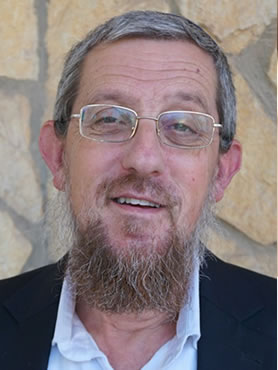A Crying for Generations
הרב זכריה טובי
ראש הכולל
"The people cried that night." (Bamidbar 14:1) Raba said in the name of Rav Yochanan: That night was Tisha B'Av eve. G-d said to them: You cried that night a needless cry, and I will establish it for you as a crying for generations." (Ta'anit 29a)
Why is the destruction of the Temple expressed as "a crying for generations?" What is the specific metaphor of crying used to symbolize the destruction?
What is the deep meaning of the Temple? The Nefesh Hachaim (Sha'ar 1, ch, 4) writes in the name of the Zohar that man's structure is similar to that of the Temple, and each part of the Temple corresponds to one of a person's limbs. The heart corresponds to the Holy of Holies, which is the center of the world, just as the heart is the center of the body. The heart sustains the life of the body, just as the Holy of Holies sustains the life of the entire world. Therefore, the true meaning of the Temple is not the physical structure of the Temple, but the sanctity of man himself, as it says: "I will dwell among them." (Shemot 25:8) It does not say, "in it," but rather, "among them" – because the goal is that the Divine Presence should dwell in each and every one of Israel.
The Malbim (Shemot 25:8) explains in this vein the pasuk: "Let them make a Sanctuary ... and so you shall do." Chazal teach: "So you shall do" – for generations. The Malbim explains: This means, do not think that the ultimate purpose of My intention is the building of the physical Temple. Rather, know that the main purpose of My will in the structure of the Mishkan and all of its vessels is that you should see from it and so you shall do – yourselves, that you should be the Temple.
This is, "So you shall do for generations – yourselves." Similarly, the prophet Yirmiya (7, 4) says: "The Sanctuary of G-d, the Sanctuary of G-d, the Sanctuary of G-d they are" – Am Yisrael themselves are the Sanctuary of Hashem.
Therefore, the building of the Temple depends on the actions of Am Yisrael. If, Heaven forbid, Am Yisrael distance from Hashem – this itself is the destruction. Thus, it says is Eicha Rabbati (1:43):
"From above He sent fire in my bones." (Eicha 1:13) R. Yehoshua said: This is what the prophet taunted and said to her, "Take millstones and grind flour." (Yeshaya 47:2) Everyone grinds grain, and you say, "grind flour?" Rather, Yerushalayim said to Babylon: If they had not made war with me from Above, would you have been able to fight against me? If from Above they had not sent a fire in me – would you have been able to overcome me? Rather, you killed a dead lion, you milled ground flour, you burned a burnt city.
The national Temple is an image of the personal temple of each one of Am Yisrael, and if the personal Temple is not – there is no room for the national Temple. This is what the Midrash Eicha says: "You milled ground flour, you burned a burnt city" – the House is burnt anyway by the spoiled actions of Am Yisrael, and there is no meaning to the burning of the Mikdash by Nevuzaraden. This it what it says, "From above He sent fire in my bones."
The Maharal, in the Aggadah of the destruction, explains the Gemara that the First Temple was destroyed on account of three sins: idolatry, murder, and adultery, which corresponds to man, just like in the Temple there were three areas:
§ The area of the Divine Presence – corresponding to the brain.
§ The area of the Levites – corresponding to the heart.
§ The area of Israel – corresponding to the liver.
The role of a person is to give the brain control over the entire body, and to sanctify his animalistic instincts. The three sins in the First Temple were the destruction of the three aforementioned organs: Avodah Zara was a destruction of thought, which is the brain. Murder was the destruction of emotions, which is the heart. Adultery is the powering of animalistic traits over human, which is the liver. The national Temple is an image of the personal temple, which is man, and since the personal temple was destroyed – this caused a destruction of the national Temple.
With this we reach an understanding of "crying for generations." Crying is something internal, an expression of a deep feeing in a person's heart. A person who cries expresses deep sadness about something that occurred to him. "The nation cried that night" – The nation cries out of lack of faith in the cherished land, a lack of faith in Hashem. "For he [the Canaanite nation] is stronger than us/Him" (Bamidbar 13:31) – there was an expression here to the inner rot of the people, which was expressed through unnecessary crying. Therefore, Chazal say: You cried an unnecessary crying, and I will give you a crying for generations. The sadness expressed through crying for generations is a rectification of the destruction, a rectification of the inner deficiency that appeared in Am Yisrael.
קוד השיעור: 3990
לשליחת שאלה או הארה בנוגע לשיעור:


 (1).jpg)


.jpg)
.jpg)
.jpg)
.jpg)